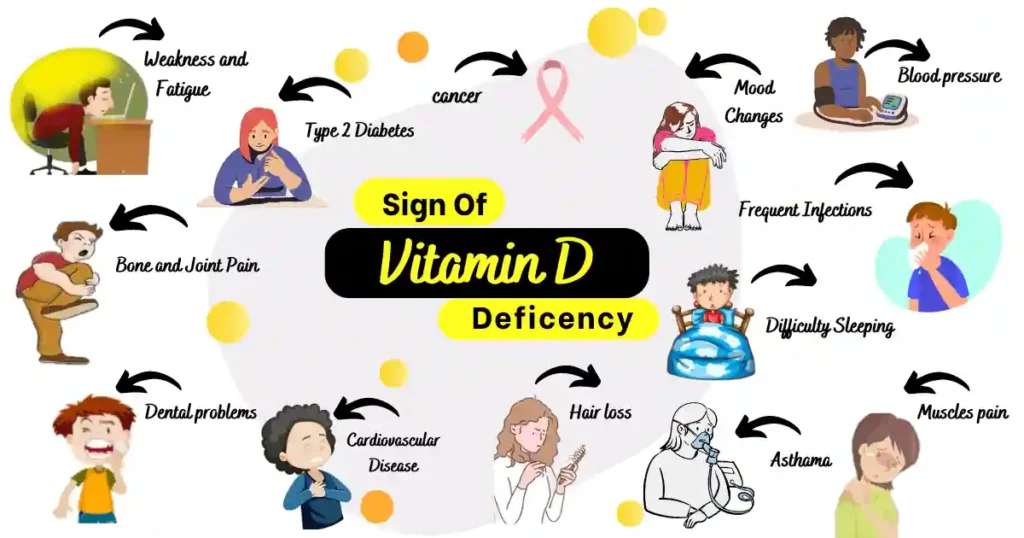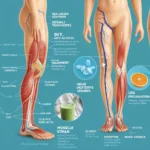Vitamin D deficiency affects people all around the world. Researchers have investigated the signs, causes, and treatment options for Vitamin D insufficiency. The immune system, healthy brain ability, and strong bones and teeth are all maintained by vitamin D. Numerous health problems can come from a lack of vitamin D. Vitamin D deficiency affects people all around the world. Numerous health problems can come from a lack of vitamin D.
Introduction- Vitamin D deficiency
Vitamin D helps absorb calcium, essential for healthy teeth and bones. The immune system, good brain function, and insulin control are all critical roles that vitamin D supports. Despite the nutritional value of vitamin D, numerous people worldwide are deficient.
What is vitamin D? and why is it essential?
Exposure to sunlight on our skin causes our bodies to produce vitamin D, a fat-soluble vitamin. Foods like fatty fish, eggs, and supplemented dairy products contain small vitamin D.
The immune system, practical brain function, and maintaining teeth and bones healthy all need vitamin D. Numerous body procedures involve vitamin D, including:
- Controlling the absorption of calcium and phosphorus
- Supporting immune function
- Maintaining healthy bones and teeth
- Regulating insulin levels

What causes of vitamin D deficiency
A vitamin D shortage can occur for several reasons. Below are a few of the most based on a:
1. Experiencing too much sun:
When we expose our skin to sunlight, our bodies produce vitamin D. But many people spend their time at home or in places with less sunlight.
2. Dark skin:
People with dark skin should increase their exposure to sunlight to absorb as much vitamin D as people with light skin.
3. Age:
Our skin makes vitamin D less effective as we age, and our kidneys have trouble converting vitamin D into an active component.
4. Obesity:
Vitamin D can get trapped in fat cells because it is a less saturated vitamin, making it less easily accessible for the body to use.
5. Health issues:
Medical disorders can change the body’s digestion and use of Vitamin D.
6. Medications:
Some drugs, like steroids and hunger drugs, can stop the body from absorbing or using vitamin D.
Also Read- Vitamin C in Winter for Skin: Nourish Your Skin with Vitamin C
What are the 14 signs of vitamin D deficiency?
Health problems like the following can occur from vitamin D deficiency: Here are 14 symptoms of vitamin D deficiency;
1. Weakness and Fatigue-
weakness and Fatigue are two of the most common signs of vitamin D insufficiency. Healthy muscular function depends on vitamin D, and vitamin D deficiency can cause fatigue and weakened muscles.
2. Bone and Joint Pain-
Bone and joint health need to be rich in vitamin D. Deficiency of it can cause bone fractures, the softness of the bone, and other health problems, as well as knee problems, fractures, joint pain, and stiffness.
3.Muscle Pain-
A vitamin D shortage can also lead to muscle pain, soreness, tiredness, and depression.
4. Mood Changes-
A vitamin D deficiency can cause depression, anxiety, and despair since vitamin D affects mood.
5. Difficulty Sleeping-
Research has linked two sleep disorders, namely hypertension and apnea, to Vitamin D deficiency.
6. Hair Loss-
Vitamin D helps promote healthy hair growth; hence, a decrease can lead to hair loss.
7. Slow Wound Healing-
Vitamin D is crucial in the healing process, and a lack can slow the healing of wounds and raise the chance of infection.
8. Frequent Infections-
A healthy immune system needs vitamin D, and a shortage increases your chance of infections like colds and flu.
9. Dental Problems-
Gum disease and dental problems such as weak, broken teeth are possible with a vitamin D deficiency.
10. Cardiovascular Disease-
Cardiovascular disease and stroke risk are both increased by vitamin D deficiency.
11. High Blood Pressure-
A low vitamin D can cause heart problems and high blood pressure.
12. Type 2 Diabetes-
Vitamin D controls insulin levels; a deficiency can increase the risk of type 2 diabetes.
13. Asthma-
Those who do not have enough vitamin D are more likely to get respiratory problems such as asthma and other issues.
14. Cancer-
Insufficient vitamin D levels may elevate the possibility of developing cancer.
Also Read- How to Increase Potassium Levels?

How is vitamin d deficiency diagnosed?
A straightforward blood test can detect it. A level of 20 nanograms per milliliter or lower is considered insufficient for vitamin D, measured in the blood during the test.
If you lack sufficient vitamin D, how do you know?
A blood test is the most accurate way to assess your vitamin D level. Blood test to check vitamin D levels. Your serum 25(OH)D level, often considered the most method to accurate of Vitamin D status, will be confirmed by the blood test. The simple test involves drawing blood from a vein in your arm. The blood test results will indicate whether your Vitamin D levels are deficient or insufficient. Vitamin D levels are typically classified as follows:
Vitamin D levels Recommended Amount
Low less than 20 ng/mL
Insufficient 20-29 ng/mL
Suitable 30-100 ng/mL
Increase vitamin D intake through supplements or dietary changes. They may also recommend increased sun exposure or light therapy.
Before making any diet or supplement changes, Consulting with a physician is essential, as excessive vitamin D can cause health problems. Regularly monitoring your vitamin D levels is critical to maintaining enough of this crucial nutrient to treat a vitamin D deficiency.
Also Read- What is Yellow Watermelon? The Colorful World of Watermelons-
How to Treat a Vitamin D Deficiency?
Vitamin D deficiency is typically treated by increasing Vitamin D intake through supplements or dietary changes. A treatment plan is determined based on severity and factors, including age, general fitness, and medical history.
Doctors advise taking vitamin D daily, depending on age and other factors. The National Institute of Health (NIH) recommends the following vitamin D daily intakes:
Stage of life Age Recommended Amount
For infants born 0 to 12 months, 400–1,000 IU (international units) every day
Children aged 1 to 18 should take 600–1,000 IU per day.
Adults 19-70 years 600-800 IU per day
Adults over 70 years 800-1,000 IU per day
A doctor may recommend higher doses of vitamin D if needed. Supplements of Vitamin D are available in various forms.
Vitamin D3 is more efficient in increasing and sustaining vitamin D levels. Fruits, grains, seafood, and egg yolks are sources of vitamin D. The best way to cure vitamin D insufficiency is to consult a doctor. Monitoring your vitamin D levels is also required to ensure you keep enough of this critical nutrient.
Also Read- Skin Lesions: What Vitamin Deficiency Causes Skin Lesions?
What are the treatment of vitamin d deficiency?
Treatment options for vitamin D deficiency include the following:
- Vitamin D-containing supplements- A supplement is the most popular treatment method for lack of vitamin D. Many different forms to take supplements, like tablets, capsules, and fluid drops.

- Sun Exposure- Sunlight can help the body make vitamin D. However, using sunscreen and avoiding direct sunlight during peak hours are crucial for protecting the skin from solar damage.
- Diet- Vitamin D-rich foods can help maintain healthy levels. Vitamin D-rich foods include fatty fish, eggs, and fortified dairy products.

- Exercise Regularly- Studies have shown that outdoors can increase vitamin D levels in the body.
- Consider UVB Phototherapy- UVB phototherapy promotes vitamin D production through exposure to UV light.

Those of us with a significant vitamin D deficiency often use this medication.
- Lose Weight: Obese or overweight people may need more vitamin D to maintain a healthy level, as fat cells store vitamin D.
- Limit Your Sunscreen Use- While sunscreen covers your face from the sun’s dangerous radiation, it can also stop the body from producing vitamin D. Try to limit your sunscreen use to only when necessary.
- Avoid smoking- Smoking is linked to reduced levels of vitamin D, making it highly recommended that individuals quit smoking.
Conclusion
Insufficient vitamin D can lead to health problems. It is necessary to recognize a deficiency’s warning signs and symptoms and take steps to maintain sufficient quantities of this essential mineral.
Also Read- Blood Sugar; 7 Diseases Were Linked to Diabetes and 10- Early Signs of Diabetes-
Hi there! I’m content writer and blogger. With over two years of experience, I’ve shared my passion for writing across various platforms. I firmly believe in the transformative power of words and look forward to sharing this journey with you. Enjoy my work!










